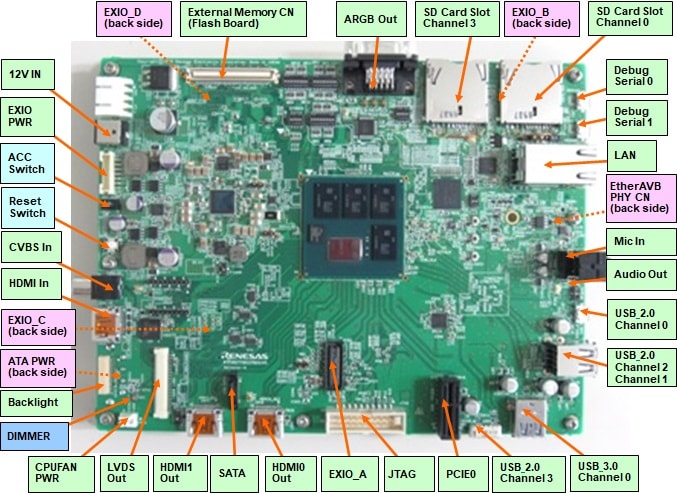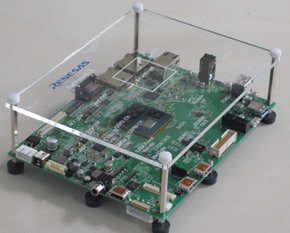If you need urgent consulting help click here
Renesas R-Car H3 Salvator-X
Overview
The H3 Salvator-X board is designed for evaluating the features and performance of the R-CAR H3 device from Renesas Electronics and it is also used for developing and evaluating application software for these R-CAR H3.
The H3 Salvator-X, based on the R-CAR H3 SIP, comes with LPDDR4 @4GB in 2-channel, each 64-bit wide+Hyperflash @64MB, CSI2 interfaces and several communication interfaces like USB, Ethernet, HDMI and can work standalone or can be adapted to other boards, via 440pin connector on bottom side.
More information about the board can be found at Renesas R-Car Development Support website.
Hardware
Hardware capabilities for the H3 Salvator-X for can be found on the eLinux H3 Salvator-X page of the board.
Note
Zephyr will be booted on the CR7 processor provided for RTOS purpose.
More information about the SoC that equips the board can be found here:
Supported Features
Here is the current supported features when running Zephyr Project on the R-Car Salvator-X CR7:
Interface |
Driver/components |
Support level |
|---|---|---|
PINCTRL |
pinctrl |
|
CLOCK |
clock_control |
|
GPIO |
gpio |
|
UART |
uart FT232RQ / CP2102 |
serial port-polling serial port-interrupt |
CAN |
can TCAN332GDCNT |
normal mode loopback mode |
I2C |
i2c |
interrupt driven |
It’s also currently possible to write on the ram console.
Connections and IOs

GPIO
By running Zephyr on H3 Salvator-X, the software readable push buttons ‘SW20’, ‘SW21’, ‘SW22’ can be used as input, and the software contollable LEDs ‘LED4’, ‘LED5’, ‘LED6’ can be used as output.
UART
Salvator-X board is providing two serial ports:
one is for A53/A57 processors
the other one is for CR7
Both ports are converted to USB through CP2102 converters and they are exposed as follows:
Connector |
Processor |
|---|---|
CN25 |
A53/A57 |
CN26 |
CR7 |
Programming and Debugging
Build and flash applications as usual (see Building an Application and Run an Application for more details).
Supported Debug Probe
The “Olimex ARM-USB-OCD-H” probe is the only officially supported probe. This probe is supported by OpenOCD that is shipped with the Zephyr SDK.
The “Olimex ARM-USB-OCD-H” probe needs to be connected to CN1 on Salvator-X.
Configuring a Console
Connect a USB cable from your PC to CN25 and/or CN26 then use the following settings with your serial terminal of choice (minicom, putty, etc.):
Speed: 115200
Data: 8 bits
Parity: None
Stop bits: 1
Flashing
First of all, open your serial terminal.
Applications for the rcar_h3_salvatorx_cr7 board configuration can be built
in the usual way (see Building an Application for more details).
# From the root of the zephyr repository
west build -b rcar_h3_salvatorx_cr7 samples/hello_world
west flash
You should see the following message in the terminal:
*** Booting Zephyr OS build v2.6.0-rc1 ***
Hello World! rcar_h3_salvatorx_cr7
Debugging
First of all, open your serial terminal.
Here is an example for the Hello World application.
# From the root of the zephyr repository
west build -b rcar_h3_salvatorx_cr7 samples/hello_world
west debug
You will then get access to a GDB session for debug.
By continuing the app, you should see the following message in the terminal:
*** Booting Zephyr OS build v2.6.0-rc1 ***
Hello World! rcar_h3_salvatorx_cr7


